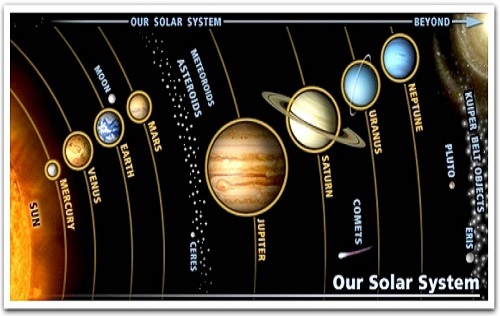Friends, below is the list of important points of solar system. This list will be helpful for all upcoming Punjab Govt. Exam.Â
Universe
Study of universe is called Cosmology
Universe is explained by the Big Bang Therory
Different galaxy in universe, Our own galaxy is called Milky Way
Nearest galaxy of milky way – Andromeda
The Solar System
Solar System consist of The sun, eight planets (Mercury, Venus, Earth, Mars, Jupiter, Saturn, Uranus, Neptune), satellites and some other celestial bodies known as asteroids and meteoroids
The Sun (99.8 percent of the solar system’s mass)
Distance From earth – 1 Astronomical unit (150,000,000 km)
Gases Found – Roughly 98% Hydrogen and Helium
Temperature on sun’s surface – 6000oC
*The light of Sun takes 8 minute and 16.6 second to reach the surface of the Earth
Planets – Eight Planets
An easy way to memorise the name of the planets in order of their distance from the sun is:
My Very Energetic Mother Just Served Us Noodles
Mercury, Venus, Earth, Mars, Jupiter, Saturn, Uranus and Neptune.
First four are inner planet – ( Mercury, Venus, Earth, Mars)
Another four are outer planet – ( Jupiter, Saturn, Uranus and Neptune)
Inner planets Called As – Terrestrial or Rock Planets
Outer Planets Called As – Jovian or Gaseous Planets
With the exception of Earth, all of the planets in our solar system have names from Greek or Roman mythology ( Question asked on previous punjab govt exam)
Mercury is the god of commerce, travel and thievery in Roman mythology.
Venus is the Roman goddess of love and beauty.
Mars is the Roman god of War.
Jupiter was the King of the Gods in Roman mythology,
Saturn is the Roman god of agriculture.
Uranus is the ancient Greek deity of the Heavens
Neptune was the Roman god of the Sea.
Some important FactsÂ
Biggest Planet -Â Jupiter
Smallest Planet – Mercury
Nearest Planet to Sun – Mercury
Farthest Planet to Sun – Neptune
Brightest Planet – Venus
Nearest Planet to Earth – Venus
Hottest Planet – Venus
Morning Star – Venus
Evening Star – Venus
Earth’s Twin – Venus
Coldest Planet – Neptune
Red Planet – Mars
Biggest Satelllite – Ganymede
Smallest Satelllite – Deim os
Blue Planet – Earth
Planet with a Red Spot – Jupiter
Brightest planet outside Solar System – Sirius (Dog Star)
Closet Star of Solar System – Proxima Centauri
Fastest rotation in Solar System – Jupiter
Slowtest rotation in Solar System – Venus
Fatest revolution in Solar System – Mercury
Slowtest revolution in Solar System – Neptune
Planet having maximum number of satellite – Jupiter (63)
Planet having no natural satellites – Mercury and Venus
Note – Earth has one natural satellite, known as the Moon
Moon-also known as “fossil planet”
Study of moon is called – Selenology
Distance from earth – 382200km
Diameter – 3475km
Gravitational force – 1/6th of earth
Size – 1/4th of earth
Other Celestial Bodies of solar system
Comet-
A comet is a relatively small solar system body that orbits the Sun. When close enough to the Sun they display a visible coma (a fuzzy outline or atmosphere due to solar radiation) and sometimes a tail.
Note- Hailey Comets reappears after 76 year
Asteroid-
Asteroids are small solar system bodies that orbit the Sun. Made of rock and metal, they can also contain organic compounds. Asteroids are similar to comets but do not have a visible coma (fuzzy outline and tail) like comets do.
Meteoroid-
A meteoroid is a small rock or particle of debris in our solar system. They range in size from dust to around 10 metres in diameter (larger objects are usually referred to as asteroids).
Meteor-
A meteoroid that burns up as it passes through the Earth’s atmosphere is known as a meteor. If you’ve ever looked up at the sky at night and seen a streak of light or ‘shooting star’ what you are actually seeing is a meteor.
Meteorite-
A meteoroid that survives falling through the Earth’s atmosphere and colliding with the Earth’s surface is known as a meteorite.
Earth
70% of the Earth’s surface is covered by water.
Equatorial Diameter – 12,756 km
Polar Diameter – 12,714 km
Equatorial Circumference – 40,030 km
Surface Temperature – 88 to 58°C
Angle of inclination – 23’30’
Mean Temperature – 22oc
Rotation – West to East
Rotation Time – 23:56:04 hr
Revolution – 365.26 days





14 Comments
Please send me the post by email.
Thanks
You are welcome Rohit
Please,Add my email for send posts
sir, punjabi writer,author,poets ki pdf file chahey
kindly add my email. u are doing a very good job thanx
sir kindly send pdf files of physics, chemistry and biology questions on my email
Increased Download limit, Download now, Password -punjabexamportal
thank u very much sir
plz send me solar system through the mail thnx
plz send me solar system and other posts hrough the mail thnx
Please Sir Send me solar system and other posts by mail thax
sir plz send me pdf file
aimfinco.ru
http://alltheholiday.ru
http://adeos.ru
http://admin-stroy.ru
http://9266111.ru